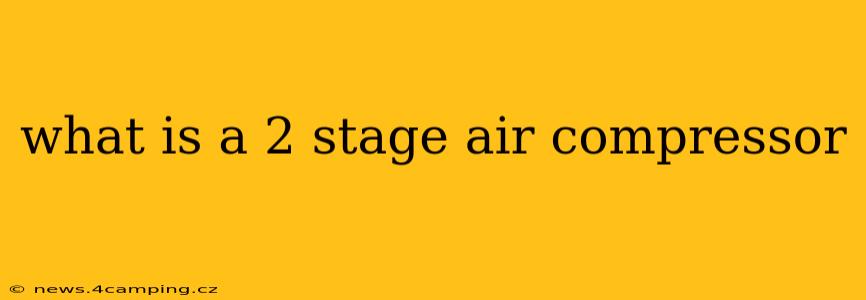What is a Two-Stage Air Compressor?
A two-stage air compressor is a type of air compressor that uses two compression stages to increase the air pressure. Unlike single-stage compressors that compress air in one step, two-stage compressors divide the compression process into two separate stages. This design offers several key advantages, making them ideal for demanding applications requiring higher pressures and increased efficiency. Let's dive deeper into understanding how they work and their benefits.
How Does a Two-Stage Air Compressor Work?
The core difference lies in its compression process. In a single-stage compressor, the intake air is compressed to its final pressure in one go. This leads to higher temperatures and increased wear and tear on the components.
A two-stage compressor, however, initially compresses the intake air to an intermediate pressure in the first stage. This compressed air then cools down before entering a second stage, where it's further compressed to the final desired pressure. This staged approach offers significant benefits:
-
Lower Operating Temperatures: By breaking down the compression process, less heat is generated in each stage. This significantly reduces the overall operating temperature of the compressor, extending the lifespan of components and improving efficiency.
-
Increased Efficiency: The cooler operating temperatures translate directly to higher energy efficiency. Less energy is lost as heat, meaning the compressor requires less power to achieve the same output pressure.
-
Higher Air Pressure: Two-stage compressors are capable of reaching considerably higher air pressures compared to single-stage models. This makes them suitable for applications requiring powerful air tools or demanding industrial processes.
What are the Advantages of a Two-Stage Air Compressor?
The advantages extend beyond just the technical aspects of compression:
-
Longer Lifespan: Lower operating temperatures and reduced wear and tear contribute to a substantially longer lifespan for the compressor's components.
-
Reduced Maintenance: Less wear and tear translate to less frequent maintenance needs, saving time and money in the long run.
-
Quieter Operation: While not always guaranteed, two-stage compressors often run quieter than their single-stage counterparts due to improved efficiency and reduced mechanical stress.
-
Superior Performance: The combination of higher pressure output and greater efficiency leads to superior overall performance, making them a preferred choice for professional and industrial use.
What are the Disadvantages of a Two-Stage Air Compressor?
While offering significant benefits, two-stage compressors also have some drawbacks:
-
Higher Initial Cost: The more complex design and higher-quality components involved in two-stage compressors result in a higher initial purchase price compared to single-stage models.
-
Larger Size and Weight: Due to the additional compression stage, two-stage compressors tend to be larger and heavier than their single-stage equivalents.
-
Increased Complexity: The more complex mechanism means there are potentially more parts that could fail, although this is offset by increased durability in most cases.
What are the Applications of a Two-Stage Air Compressor?
Two-stage air compressors are frequently used in applications demanding high pressure and reliability, including:
-
Industrial Manufacturing: Powering pneumatic tools and machinery in factories and manufacturing plants.
-
Automotive Repair: Operating air tools and equipment in automotive repair shops and garages.
-
Sandblasting: Providing the high-pressure air necessary for effective sandblasting operations.
-
Spray Painting: Delivering consistent and powerful airflow for efficient and high-quality spray painting.
What is the difference between a single-stage and two-stage air compressor?
The primary difference is the number of compression stages. A single-stage compressor compresses air in one step, resulting in higher temperatures and potentially less efficiency. A two-stage compressor divides the compression into two stages, reducing heat generation and improving efficiency and pressure capabilities.
When should I choose a two-stage air compressor over a single-stage air compressor?
Choose a two-stage compressor if you need high air pressure, prolonged operation at high pressure, longer lifespan, and better efficiency. If you have lighter-duty needs and a tighter budget, a single-stage compressor might suffice.
By carefully considering the advantages and disadvantages, and by understanding your specific air compression needs, you can make an informed decision about whether a two-stage air compressor is the right choice for you.
